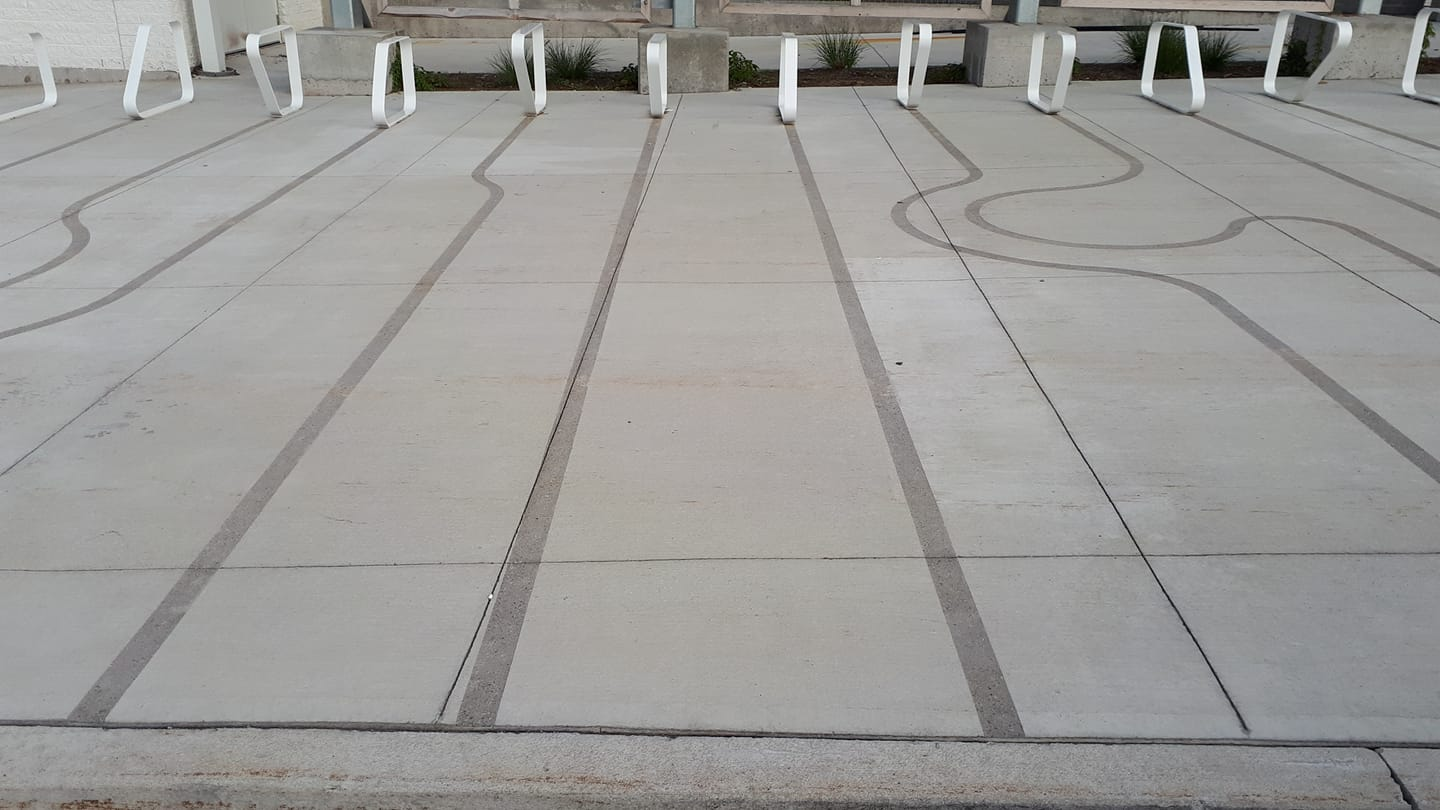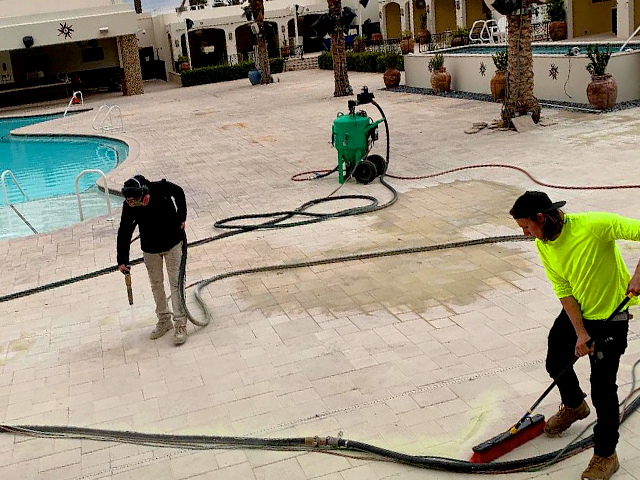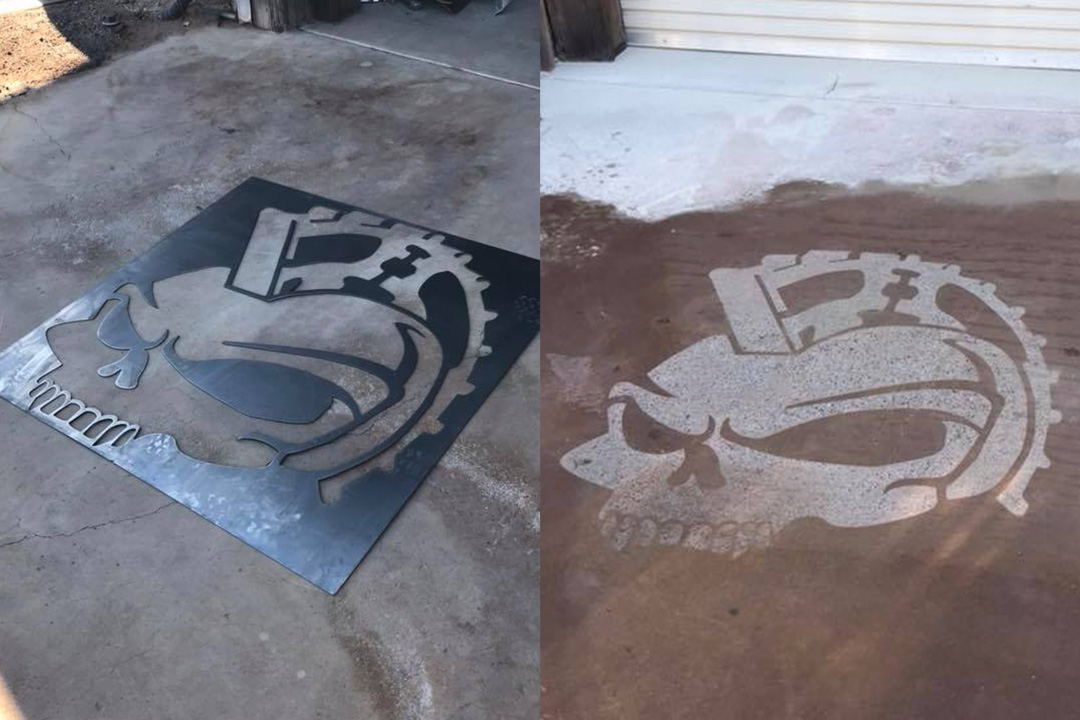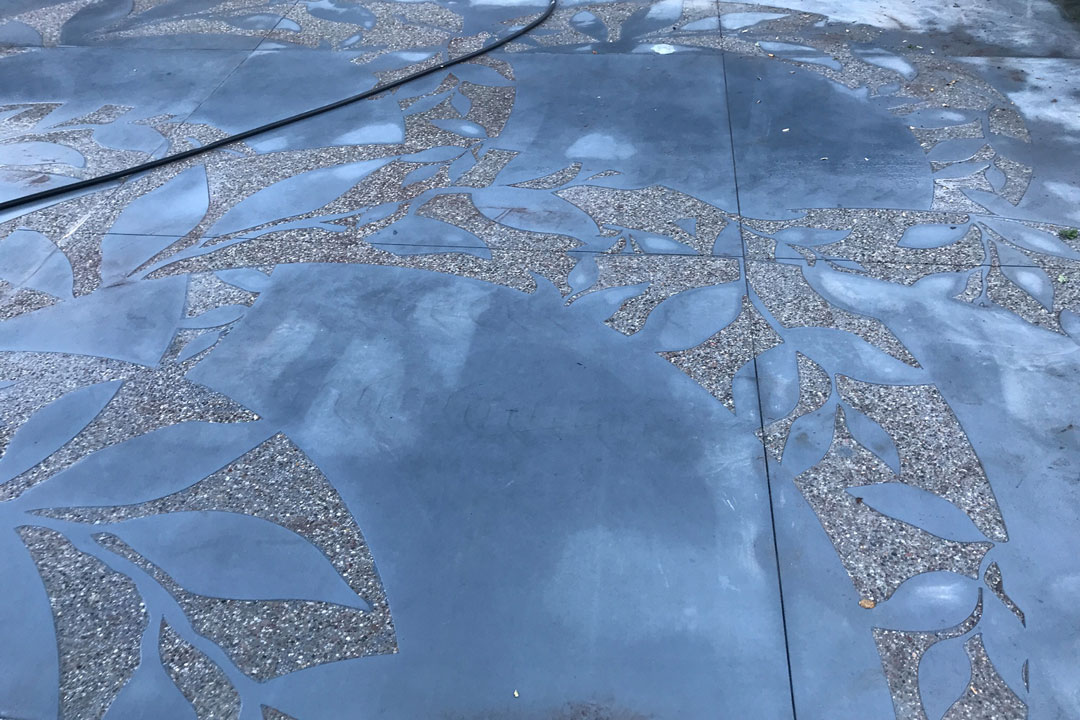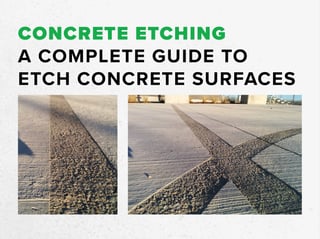
Concrete is one of the most durable and long-lasting materials used in construction. However, even the strongest concrete surfaces can eventually become worn or stained, detracting from their overall appearance. Concrete etching is an excellent way to refresh and revitalize the look of concrete surfaces. And with Dustless Blasting equipment, it's now easier than ever to achieve professional-looking results with minimal mess.
For all things related to concrete resurfacing, view this guide.
What is Concrete Etching?
Concrete etching is a cleaning process that opens the pores of the concrete to prepare the surface for the next treatment. This allows the coating to better penetrate and adhere to the surface, providing a better, longer lasting finish. It can also be used to create decorative patterns or designs on new concrete surfaces. Etching can be done manually using specialized tools, or even with the help of Dustless Blasting equipment.
What Are the Benefits of Concrete Etching?
Etching helps to restore and revitalize old, stained, or discolored concrete surfaces and is an important step to carry out if you’re looking to apply a new coat of paint. Below are several benefits of concrete etching:
-
Improved aesthetics: Concrete etching can add patterns, designs, and textures to plain concrete surfaces, making them more visually appealing.
-
Increased durability: Concrete etching can increase the durability of concrete surfaces by creating a rough texture that improves traction and reduces the chances of slips and falls.
-
Easy maintenance: Etched concrete surfaces are easy to clean and maintain. They are resistant to stains, dust, and dirt, making them ideal for high-traffic areas.
Overall, etching is a great way to restore, protect, and add decorative flair to concrete surfaces in both commercial and residential applications.
Different Methods of Concrete Etching
• Abrasive Blasting – Abrasive blasting is a mechanical process that uses high-pressure air to blast abrasive material onto a surface to etch it. This process has proved to be more efficient and safer than grinding or using chemicals, especially if you use a system that can wet blast - like Dustless Blasting.
• Diamond Grinding – Diamond grinding is a process that uses diamond-tipped tools to grind down the surface of concrete. This method is ideal for removing tough materials like grout without damaging the concrete, and it can be used to create decorative patterns in the concrete as well.
• Chemical Etching – Chemical etching is a process that uses chemicals to etch or “etch” away the top layer of a concrete surface. It can be used to create decorative patterns, but it’s also more aggressive than diamond grinding and sandblasting and can cause more damage to the concrete if not done properly.
THE ETCHING PROCESS
Gather Your Safety Products and Gear
The necessary proper protective equipment (PPE) required when concrete etching is a must. This not only includes safety glasses, gloves, and dust masks, but also hearing protection should be considered. Additionally, respirators are also an important element in the work environment. Make sure all of your PPE meets OSHA standards as well as state and local regulations to ensure maximum safety when etching concrete.
Prepare the Area
You’ll need to prepare the concrete surface for etching or grinding by cleaning it and removing any loose debris. Etching should only be done on bare concrete, so you'll need to make sure that paint, sealers, and curing compounds are completely removed before continuing. A wire brush can be used to help remove these materials along with any dirt and stains. After the surface is cleaned, use a vacuum cleaner to remove all dust. Finally, make sure that the concrete is damp before etching or grinding begins. This will help keep the dust down and prevent it from becoming airborne. If you're using a Dustless Blasting system, you can simultaneously clean and etch the surface - saving time.
Begin the Etching Process
Depending on the type of concrete, this may be a chemical etching solution or a mechanical grinding system.
Chemical etching involves using acidic solutions to create designs on the surface of the concrete. The acid solution is applied to the surface, and it reacts with the cement paste, dissolving it and leaving behind a rough texture that can be stained or painted. After applying the solution, rinse off thoroughly with clean water making sure all traces of the solution are gone before proceeding.
Mechanical etching, on the other hand, involves using tools such as grinders, media blasters, and shot blasters to create designs on the concrete surface. These tools remove the top layer of the concrete, leaving behind a rough texture that can be stained or painted.
Allow Concrete to Dry
Once washed clean, allow the concrete to completely dry before proceeding with the next step. This may take up to 24 hours depending on how wet it was after rinsing off the etching solution. Take care to ensure that no moisture is left on the surface before moving on.
Apply New Coating
Now that the concrete is ready, it's time to apply your new coating. Depending on what you're using, either paint or sealant, make sure to read directions carefully and follow any instructions for proper application. Apply even coats in a thin layer making sure not to miss any spots. Allow ample time between coats to ensure that the coating adheres properly and will last as long as possible.
Enjoy Your New Look
Congratulations, you've successfully completed your new concrete project! With the right prep work, your new paint or sealant should look great for years to come. Enjoy the new look of your newly refreshed concrete surface!
Newer, Safer Practices
There are safer and cleaner alternatives when it comes to concrete etching and grinding like Dustless Blasting. This method uses a combination of water and abrasives, which helps contain the dust generated from the project. The benefits of Dustless Blasting don't end with safety and cleanliness. Dustless blasting is also faster than traditional etching and grinding methods and can be used to etch concrete, masonry, and stone surfaces.
What is Dustless Blasting?
Dustless Blasting is a revolutionary surface preparation method that uses water and abrasive media to clean and prepare surfaces for a variety of applications. This process is particularly effective for concrete etching because it combines the cleaning power of traditional sandblasting with the added benefit of being virtually dust-free. This is especially important on concrete surfaces because they contain silica sand. Dustless Blasting equipment eliminates the hazardous dust plume you see with traditional sandblasting and grinding.
Advantages of Concrete Etching with Dustless Blasting
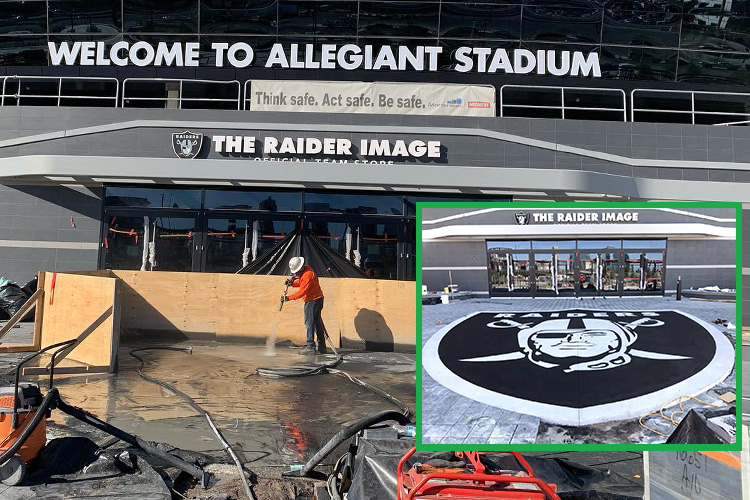
There are several advantages to using Dustless Blasting equipment for concrete etching. Some of the most notable benefits include:
-
Dust-free process: Traditional sandblasting methods can produce a significant amount of dust and debris, which can be hazardous to both workers and the environment. Dustless Blasting equipment significantly reduces the amount of dust produced during the etching process, making it a safer and more eco-friendly option.
-
Reduced clean-up time: Because Dustless Blasting equipment is designed to minimize dust and debris, clean-up time after the etching process is significantly reduced. This can save both time and money, making Dustless Blasting a more efficient option.
-
Improved precision: Dustless Blasting equipment allows for greater precision and control during the etching process. The operator can adjust the pressure and flow of the water and abrasive media to achieve the desired level of etching, resulting in a more precise and uniform finish.
-
Faster results: Dustless Blasting equipment is designed to be fast and efficient, allowing for faster results compared to traditional etching methods.
-
Versatile: Dustless Blasting can be used on a variety of surfaces, including concrete, brick, stone, and metal. The operator can adjust the pressure and flow of the mixture to achieve the desired result, creating a variety of textures and finishes.
- Cost-Effective: Dustless Blasting is a cost-effective option for concrete etching because it can be completed quickly and efficiently, reducing labor costs and downtime.
Acid Etching vs. Grinding VS. DUSTLESS BLASTING
Acid etching vs. grinding is a common comparison when deciding the best way to prepare concrete for sealing. Acid etching with muriatic acid is a popular method due to its low cost and availability; however, it can be dangerous to work with as improper use can cause skin irritations or burns. Grinding concrete removes more material than acid etching and can even create a polished look. It is a more complex and time-consuming process, but it provides better adhesion when applying sealer to the concrete surface. With either option, appropriate safety precautions should be taken and proper ventilation used due to the strong odor of the chemicals or dust.
Concrete etching with Dustless Blasting equipment is an excellent option for anyone looking to refresh or restore the look of their concrete surfaces. The process is safe, eco-friendly, and efficient, and can produce professional-looking results with minimal mess compared to grinding. Whether you're looking to clean and restore an old concrete surface before applying new coating or add decorative patterns and designs to a new one, Dustless Blasting equipment can help you achieve your desired results quickly and easily.
DECORATIVE CONCRETE ETCHING
Decorative etching can also be used to create a unique look and feel for your concrete, granite, stone, or wood surfaces. You can etch patterns, designs, and logos into the surface of the concrete. This is an ideal solution for anyone looking to add a little something extra to their surfaces. You may also want to consider adding color or texture, this can be done through painting or staining the concrete surface and even adding decorative chips or stones. This will help to give your concrete surface a unique look and feel that is sure to be eye-catching. No matter what type of finish you choose, make sure to properly prepare the surface before beginning any project so that you can ensure long-lasting results.
Decorative etching with Dustless Blasting equipment is a game-changer in the industry. With this innovative technology, concrete surfaces can be etched with precision and speed, without the usual hazards and mess of traditional methods. In addition, this method does not require any harsh chemicals or abrasives which can cause damage to the concrete. The result is an even, professional finish that lasts for years. Dustless Blasting also uses up to 80% less water than traditional methods, and can be done with minimal disruption to your lifestyle.
Concrete Efflorescence Removal
Concrete efflorescence is a white, powdery substance that may form on the surface of concrete when moisture is present. To remove efflorescence from your concrete surface, dustless blasting can be used. Dustless blasting works by propelling tiny abrasive particles at high pressure against the surface. This removes the loose material and leaves a clean and uniform finish.
Pros and Cons of Acid Etching
There are pros and cons of acid etching concrete too. On the plus side, acid etching is relatively inexpensive and effective for removing paint and other coatings from concrete surfaces. However, it’s important to use protective gear when working with acids as they can be hazardous if not handled properly. Additionally, acid etching doesn't work on all types of concrete and can create uneven surfaces in certain cases. Acid etching also requires more time and prep work than other methods, such as dustless blasting. Overall, acid etching is an effective and cost-efficient method for removing coatings from concrete surfaces, but it may not be the best tool for certain jobs. Dustless blasting delivers superior results in less time with fewer safety risks. So, consider dustless blasting as an alternative to acid etching when working with concrete surfaces.
Types of Acids for Etching Concrete
These are the different types of acids used in etching concrete:
• Hydrochloric Acid – This type of acid is a strong mineral acid that can be used to etch concrete surfaces. It’s available in both liquid and powder form and is known for its ability to quickly break down tough materials like grout. The downside of this type of acid is that it can be dangerous to use and can cause chemical burns if not handled properly.
• Muriatic Acid – This is another type of acid used to etch concrete surfaces, however it is much weaker than hydrochloric acid and isn’t as effective at breaking down tough materials. It’s typically used in more decorative projects that don’t require as much etching power.
• Citric Acid – This is a weak acid that can be used to etch concrete surfaces, however it has the added benefit of being less hazardous than hydrochloric or muriatic acids. It’s best for non-structural applications and lighter etches.
• Phosphoric Acid – Phosphoric acid is a milder and less dangerous etching agent than hydrochloric or muriatic acids. It’s great for lighter, decorative applications because it won’t damage the surface of the concrete, but it won’t be effective in breaking down tough materials like grout.
• Sodium Carbonate – Also known as soda ash, this is a mild alkaline compound baking soda that can be used to etch concrete surfaces. It’s non-hazardous and won’t damage the surface of the concrete, but it’s not as potent as hydrochloric or muriatic acid so it’s best used for light etching and decorative applications.
Pros and Cons of Surface Grinding
There are pros and cons of surface grinding concrete surfaces. On the plus side, it is quite efficient; it can cover large areas quickly and effectively with minimal effort. It’s also fairly cost-effective compared to other concrete surface treatment methods. On the downside, surface grinding can create a significant amount of dust that can be hazardous. Additionally, the grinding process can damage the surface, creating a need for repair work. This can add to the cost significantly. It’s important to weigh the pros and cons carefully before deciding whether or not it will be the right choice for your project.
Leave the Etching Product on for the Recommended Amount of Time
How long should you leave the etching product on? This will depend on the specific product, so be sure to read the instructions carefully. Generally speaking, you want to keep it on for the recommended amount of time outlined in the instructions before rinsing it off. Applying too little or too much product can have adverse effects and damage your concrete surface, so it’s best to follow directions closely. Once you’ve completed the etching process, your concrete is now ready for a new coating or sealer. This will help protect the surface from wear and tear, as well as preserve its look and feel for years to come.
FAQ
Can I Use a Grinder to Roughen the Surface of My Concrete Instead of Acid Etching?
Can I use a grinder to roughen the surface of my concrete instead of acid etching? Yes, you can use a grinder to roughen the surface of your concrete in place of acid etching. Grinders are often used in place of the acid etching process as they can be faster and more efficient at removing tough materials like grout. However, it is important to note that this method can be quite aggressive and can cause damage to the concrete if not done carefully. Additionally, depending on the texture you are looking for, other methods may be more suitable such as diamond grinding or abrasive blasting.
How Soon Can I Etch My Garage Floor After Fresh Concrete Has Been Installed?
You can begin the concrete etching process after the concrete has cured, which usually takes 21 days. If you are using acid-based etching products, it is important to wait until all of the moisture has evaporated from the concrete before beginning the process. Additionally, any contaminants such as any oil stains or grease should be removed prior to etching with an approved cleaner. Once these steps have been completed, you can begin the etching process. It is important to note that depending on the size of your garage floor and the texture you are looking for, it may take several hours or days to complete.
When Can I Start Coating My Garage Floor?
This can usually be done immediately after the etching is complete. You should wait approximately 24 hours to give the floor time to dry, then you can begin applying any coatings of your choice. Be sure that all surfaces are free from dust and debris before starting to apply the coating. Allow each layer of coating to completely dry between coats according to manufacturer instructions. It is best to complete the entire coating process all at once, rather than breaking it up over a period of time. This will help to ensure that you achieve an even and consistent look for your garage floor. Once all of the coats are applied, allow another 24 hours for drying before using the garage floor.
What Happens if I Do Not Prepare My Concrete Floor Before Coating?
If you do not properly prepare your concrete floor before coating, the results will be less than ideal. The coating may not adhere to the surface, and it could wear off easily after extended use. You could also see cracking or bubbling over time due to inadequate preparation of the surface. It is always best practice to ensure that your garage floor is properly prepared before beginning the concrete coating the process. Doing this will help you to achieve a long-lasting and attractive finish for your garage floor.

